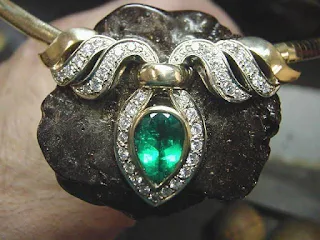Different types of Duplex
or “Flex-Shaft” handles for Diamond Setting!
Some of these handles are good and some are 'just great', you pick! If you contact any tool company, the answers could be that there are some other kind of handles for you to use.
These have been my "setting-friends" for many decades, I'm only explaining my past experiences in using them.
====================================================
(Located @ the bottom of the handles)
Style #30. The handle is great for jewellery
manufacturing, but is it good for Gemstone Setting? NO! Here are the reasons
for and against!
Against: It
has very limited, or no freedom to move the bur around the item for setting. It
is literally physically ‘joined’ to the heavy shaft and movement is not great
for simple stone setting. A poor choice of a handle for setting! This handle does not come with a ‘Duplex, Flex-shaft’.
Weight: 155.6 grams. On
a scale of 10 for setting, I’d give it a 3…maybe!
It is very 'wide
& heavy' to hold, your fingers cannot get close to the rotating bur.
For: It only has one ‘for’, is that it can take any size of a bur-shaft!
---------------------------------------------------------------------------------------------
(Located @ the third from the top)
“Duplex, Flex-shaft; with a finger-tightening system”: (#n/a)
For: This
is very reasonably priced handle: Under $100.00, for a beginner in setting I
suggest you buy this for a start. Weight: 155.0 grams
Your fingers
can ‘almost’ get close to the actual setting. It is quite easy to hold and the
‘flex’ gives the setter more freedom. Out of a 10 of great, I’d give it a definite
6.5!
Against: It still has ‘some limited’ movement.
If the ‘Flex shaft’ needs repair, it can be quite costly, as much a new
handpiece! It has some limited use at the setter’s bench, but not for continual use!
There is heat build-up during long term setting!
----------------------------------------------------------------------------------------------------
(Located @ the second from the top)
Micro-Motor Handle! The ‘only’ apparatus to buy, no heating in the shaft,
because there is nothing to heat up! Very little need for any repairs. The
fingers of the setter can get very close to the rotating bur while in motion. The electric
fan is located inside the handle. There is no ‘limited movement’, total freedom at all times! The ultra-quiet, internal motor is inside the handle. The total weight is 190.8 grams. I rate this at a definite 10+,
on my 10 scale of approval!
Against? I have not yet had any problems in my
many years. Just a wonderful tool have and use. BTW, I have two of these great machines!
---------------------------------------------------------------------------------------------------------
( Located @ the top of photograph)
“Reciprocating Hammer” I call this particular hammer my Roll-Royce or a Mercedes, why so? I paid loads of dollars for it, but after
2-3 setting jobs, it was literally paid for. If you take absolute care of this
remarkable hammer handpiece, you should have many YEARS of continual use,
trust me!
Just how delicate can this hammer get? I have just one photograph to show you and then you be the judge.
















